Here I go again…
Venturing into another “controversial” subject… I’m such a rebel.
Nope, I’m not talking about GMOs, or vaccines, or any of that stuff today. But rather, diatomaceous earth.
Whooooooooo…. Crazy, huh? I have such a knack for happening upon controversy in places I’d never expect it. But maybe that’s because we live in the age of the internet and even the slightest, silliest things are controversial these days. (Does anyone else get tired of that? Man oh man, I sure do… But that’s a topic for another day…)
Anyway, back to the diatomaceous earth.
You’ve heard me talk about DE before here on the blog. In fact, one of my most popular posts ever goes into all the details of using diatomaceous earth around your home and for your health.
However, even though there are all sorts of diatomaceous earth uses in your home and medicine cabinet, I actually use it outside my home, more than inside.
I sprinkle it in my chicken coop to cut down on flies, use it on my barn floor, and occasionally dust my garden with it as well. And since I’ve received tons of questions about using diatomaceous earth in the garden, that’s what we’re diving into today.
But first, a little background.
What is Diatomaceous Earth?
Diatomaceous earth (buy it here) is a ultra-fine white powder made from the fossilized remains of algae-like plants (aka diatoms).
There are a lot of different health claims attached to DE, but I personally am most interested in the pest control aspects of the stuff.
Diatomaceous earth purportedly works as effective, natural pest control as the fine powder is razor-sharp on a microscopic level. It slices into the exoskeleton and dries the insect out. Because it works from a mechanical standpoint, versus a chemical one, you don’t have to worry about insects developing a resistance, or spraying toxic pesticides on your plants. Which is why a lot of naturally-minded folks are fans of the stuff.
Diatomaceous Earth Safety
As soon as I even whisper the word “diatomaceous” online, I get pounded with emails and comments from people loudly proclaiming the “dangers” of DE. So I’m going to beat y’all to it today. 😉
Yes, there are some considerations to take into account when handling DE. Do I think it makes diatomaceous earth something to be afraid of? Nope. But do use common sense, and follow these guidelines:
- Always, always make sure you’re using food-grade diatomaceous earth, not the stuff designed for swimming pools.
- DE is a ultra-fine powder, which means it’s not great for your lungs. So avoid breathing the dust, or wear a mask when you apply it.
- DE is drying, and while it won’t cut your skin like it will an exoskeleton, it does feel funky if you get a lot of it on your hands. Feel free to wear gloves when you use it.
Diatomaceous Earth in the Garden
As you know, I’ve been locked in battle to save my veggies from hungry insects this year. I’ve been using my DIY Organic Pest Control Garden Spray recipe on the veggies getting hit the worst, and also sprinkling on some DE as needed. Which sparked an interesting conversation on my Facebook page the other day.
Diatomaceous Earth and Bees
Recently, it’s been brought to my attention that many folks are concerned about using diatomaceous earth in their garden because of the effect it may have on beneficial insects, especially bees.
As many of you know, the bee population is declining, which is a very serious problem. I wouldn’t want to do anything to add to this issue, so I decided to investigate further. Here’s the issue with bees and DE (in a nutshell):
1. You sprinkle DE all over your garden like crazy.
2. Bees come visit your garden to pollinate the flowering plants.
3. Bees land in the DE. Bees try to groom the DE powder from their legs.
4. Bees die = not good.
This has caused a number of gardeners to become very much against any use of diatomaceous earth at all. Nada. Zero. Zilch. However, I prefer a balanced approach of looking at issues, so I decided to investigate further.
After talking to a local beekeeper, and reading a number of perspectives, it seems as though the importance lies in how we apply DE, versus the notion that simply DE on the premises is inherently bad.
I have decided to follow these strategies for continuing to use diatomaceous earth in my garden, while keeping the bees in mind at the same time.
- Apply DE sparingly, and only to plants that are seriously effected by insects. For me, that’d be my poor beets this year. They are being eaten down to nothing…
- Apply DE in the early morning, or late evening, when bees are less likely to be out.
- Apply DE close to the ground, where bees are less-likely to land.
- Do not apply DE to flowering plants where the bees would be landing to pollinate.
- Apply DE on non-windy days to avoid it being spread over the entire garden.
Do I still think using DE is better than chemical pesticides. YES. Just only use it where you need it and use it with discretion.
How I use Diatomaceous Earth in the Garden:
1. DE is easiest to apply if it’s in a shaker container of sorts. If you only need to use a small amount, you can repurpose an old spice shaker. I needed a larger amount, so I poked holes in the lid of an old plastic coffee can.
2. Sprinkle DE on the plants being eaten by insects. Follow the considerations for bees above. Only use DE on the plants in your garden that need it. Don’t dust it all over everything.
3. Reapply after heavy rain, or watering.
Does it work?
It sure seems to– at least for me. I have noticed a decrease in insect problems after applying. The main disadvantage to DE is that you must continually reapply it, so it can be a bit of a chore. But if you are consistent, I do think it can be an effective garden pest control method which does not rely on harmful pesticides.
Let’s Sum it Up:
- Don’t stick your head in a bag of DE and huff it. Your lungs will not be happy.
- Don’t jump into a tub of DE and rub it all over your skin. Unless you want to feel dry and crusty.
- Don’t go crazy and dust DE all over your garden. Respect the bees and allow them to do their job.
- Don’t use DE if you don’t want to. Seriously. If you’d rather not use DE in your garden, that doesn’t bother me a bit. You can opt for a natural, homemade garden pest control spray instead, pick the bugs off by hand, or just buy veggies from the Farmer’s Market. Any of those options are just fine by me.
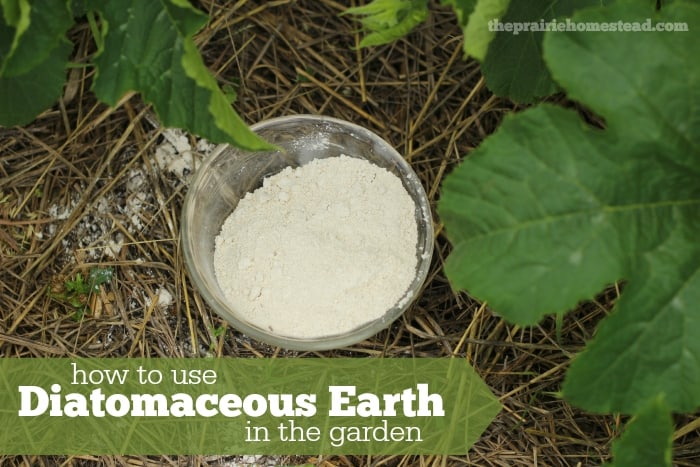
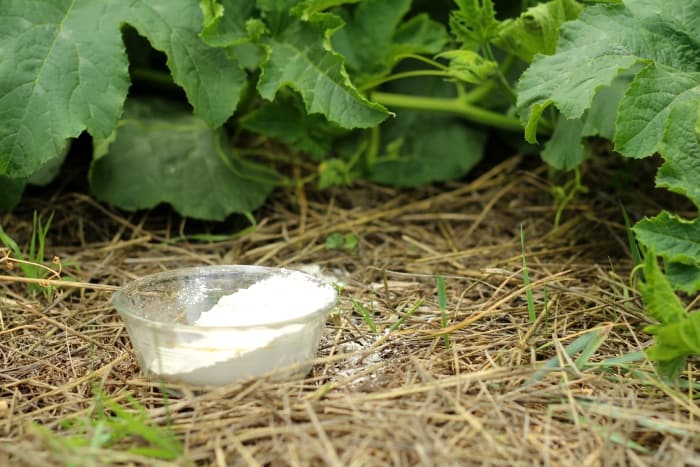

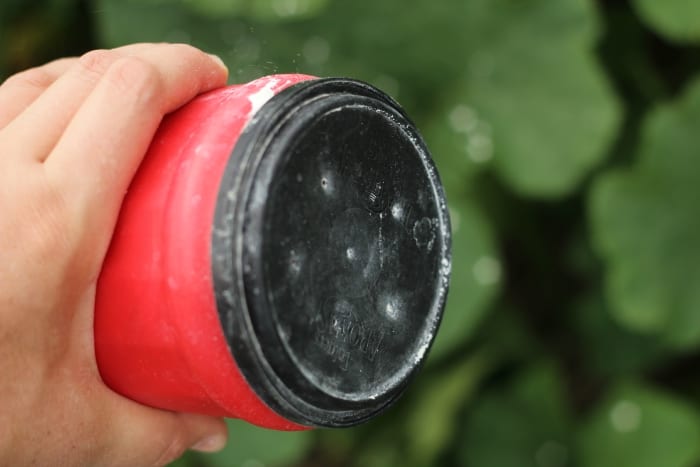
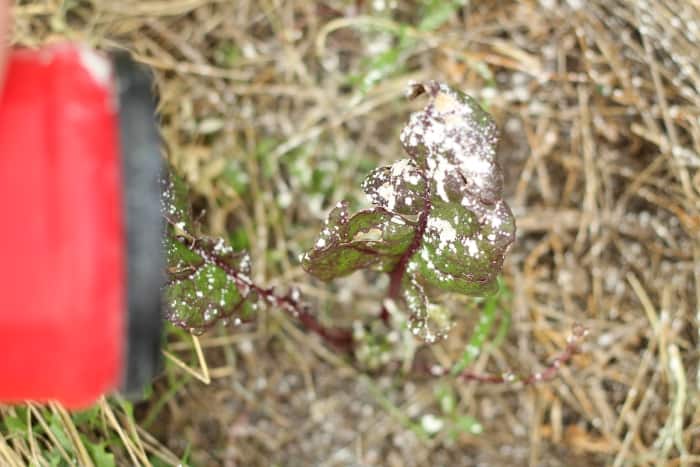
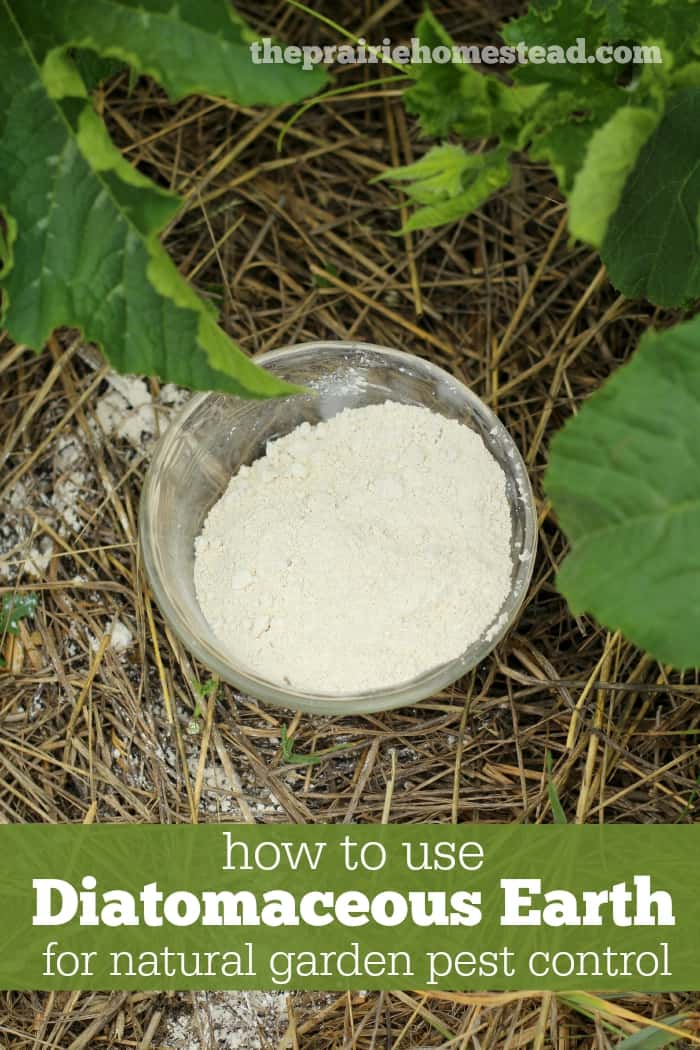

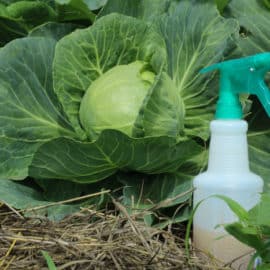

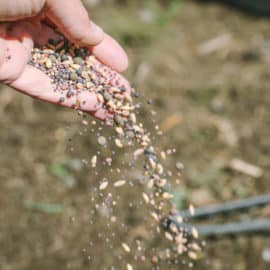
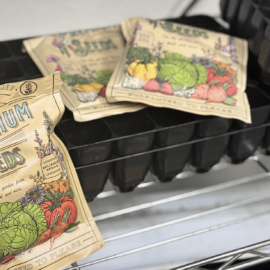
Great post! 🙂 I use DE as needed in my garden. This year I haven’t had many problems with bugs so I haven’t had the need for it. But I have researched it myself and I’m comfortable using it in my bug control arsenal.
Have you ever tried it on fireants they are destroying my trees and shrubs. Thanks so much for your time .
I don’t know about fire ants, but I sprinkled some on a big trail of black ants the other day and looked about ten minutes later and there wasn’t an ant to be found in that area. So it might be worth it to sprinkle a bit on a couple areas where you see them congregating, just to see what happens. I do keep DE use to a minimum to avoid hurting the good insects, as others have mentioned too.
Good luck!
I spread a solid narrow (about an inch wide) trail of DE around the foundation of my Gulf Coast home and have not seen one roach or scorpion so far this year. I also spread it around my AC compressor since ants were invading the relays causing failures- problem solved. Like any exoskeleton insect, fire ants don’t stand a chance. A circle of DE around their mound will wipe them out within a few days
Great to know Roy!
Is it useful for flea control on your lawn or in your garden for your dogs infestation of fleas.
Does anyone have any experience using it to deter leaf cutter ants? I’m happy to have the ants and let the horny toad lizards eat them, but I don’t like them stripping my plants of their leaves.
Thanks I’m contained with the information thanks
Can DE be tilled in or will that cause loss of effectiveness?
Does any one know if I till in the DE in my soil so it mixes well before I start my veggie garden would be a smart choice
By a “puffer”….it will produce a very light mist of DE and thats really all you need.
I want to use DE to combat root maggots in my carrot crop…but I am concerned about earthworms. Such a softbodied critter it is bound to hurt them……any thoughts?
Loved this post! Amusing and informative all in one well written package.
Thanks Valerie!
Haha~made my morning as well.
Thanks Jill?
I am a nookie on gardening and producing food and dairy but I am having a blast.
Yes,battle with all( I mean all kind of…) the creatures is biggest energy/$$ consuming for me.?
DE, I’m not sure if it’s working or not but I just stick with it and hope for the best.
I have been drinking it with some juice my self?taste like a good dirt?
I watched a video earlier this year when I became interested in applying DE to my green beans, expecting lots of bean beetles. I watched this guy use several different ideas for application, but the best, best, BEST one he used was a … (let me try and explain) you know the water bottles that are used on the sidelines of a football game. The plastic bottles that have the straw that goes to the bottom and comes up through the top making a sharp 45 degree turn? Anyhow – those bottles left just a dusting on the leaves – it was so incredibly impressive! Thought I would share that with ya – in case you find one white you’re out scouting the sporting goods stores (LOL!). I’ve yet to find one to use myself, but I’m on the lookout for the future. Luckily bean beetle haven’t been horrible this year.
oooh… super smart idea!!
You and your readers have superb ideas!!
This is really interesting and makes me want to do a little more research. We had a mite infestation in our chicken house during a heat wave last month, and my final step in resolving it was to sprinkle the cleaned house thoroughly with DE. It’s completely stopped a mite comeback and has also eliminated the flies and odor that would normally be there. Yay DE! I’m now wondering if I can still clean out the coop and put the droppings/shavings/DE mix in my garden to rot down and fertilize it. I would hate for the DE to destroy all the worms and microorganisms when I’m trying to enrich my soil. I’d love your opinion! Thank you for all you share.
I sprinkle it in the coupe once a month, as well as the dust bath. It will kill the mites. Also, recommended as a natural dewormer for the girls too. I mixed in with their food in the spring and fall.
If I am understanding you correctly on this amazing product , it would work great for fly control. Will it hurt dogs and cats. Was almost thinking I can put a little bit in a small hanging container with some sugar on the bottom to attract flies and maybe put some under the dogs bedding. Thanks for your great post. Blessings, Sandy
Hi! Yes it’s safe for pets (good grade DE). We just started using DE this Spring. I sprinkle it (with a parmesan cheese shaker) on the garden soil for ants and straight on the dogs beds and bellies to kill fleas. Not sure how long it takes to work but we do reapply when they get itchy again. I did read DE is supposed to kill chiggers too so we sprinkled the back yard. It didn’t work quite as well as we had hoped but did make it better. Our organic non-gmo chicken feed has it included in the feed and we sprinkle some around the coop to keep bugs out too. We’ve become big fans! Does anyone have any other natural flea remedies we could try on the dogs as well, possibly using oils? 🙂
Ugh autocorrect! Sorry it was supposed to say “food grade DE.” By the way, I love the site Jill. I listened to the Oil Revolution seminar and became a big fan of yours. Keep up the great work! 🙂
So thrilled to have you Allison– and happy you’re enjoying the blog and the seminar!
Oh yes, I have used a few different products and they all work on my dogs and cats for eliminating fleas.
1. Neem powder dusted on the animal, or bathe them in NEEM soap. Or, I have Neem oil and I just mix a little with organic dish soap and bath the dogs with it and apply a few drops on the back of their neck. Neem really smells though so test it out first.
2. CedarCide. Amazing product if you love the smell of cedar. My daughter washed her baseboards and around the carpet in that area since she found fleas congregating there. You can apply it directly onto the animal and you can also use some with soap to wash your animal too.
3. I have a recipe for essential oils to keep bugs/ticks/fleas off humans and animals.
4. MMS. If you think DE sparked controversy wait till you bring up the subject of MMS or Sodium Dioxide and this product. I have used it for several years and love it. I hate the smell because it smells like chlorox but it does the job. You need a solution of Sodium Chlorite and another solution of Citric Acid. Then its a ratio of 1:1 and you put the drops in a glass container and let them activate for 20sec then add water. Feel free to contact me if you have questions on this product. And no, IT IS NOT BLEACH. I use the activated drops on and in my animals, I have taken it myself and have given it to my children with great success in reversing food poisoning, colds/flus etc. You can make eye washes, vaginal douches, and treat skin infections and ear infections (plus more) You have to go slow and low with the drops if you take them orally~that’s where calling me is a good idea. 🙂
valerie@HealthyBalancedWomen.com
707-474-9670
I am also an MMS believer! I’ve been using it for at least ten years and in many cases it has literally been a lifesaver. It is wonderful to hear of someone else that uses it with great success. You are right about the controversy though, most people either look at me and go “Huh?” or tell me how bad it is, even though they have only read about it on the internet. It’s a shame that more people don’t know about it or trust to use it. You are absolutely right, it’s great stuff!
We use brewers yeast chewable tablets (without garlic) purchased from the health food store (NOW Brand 600 mg 200 count) lasts quite awhile for our cat and dog. We give them each one tablet each morning. They are small so it only takes one a day. If you have a larger dog, then 2-4 depending on their weight. We have been using this method for two years now, and not a flea one. 🙂
I sprinkle food grade DE on my animals and we never have a flea problem. I also mix it in their food a few days a month to help keep them free of internal parasites. It works great and keeps them worm free.
Yes, it is considered safe for dogs/cats. I would just avoid doing any heavily dusting when they are hanging around, as it might make them cough.
Awesome article! Will use on my garden next year. The grasshoppers ate the whole garden. Husband tried spraying with hot pepper juice. Think it just seasoned it for them.
When I make my pepper spray the peppers I use are habaneros peppers. My beans were being devoured by Japanese beetles. I have not seen a one in 2 weeks.
Oh yes– I bet habaneros work like magic!
To answer the question on fleas. Braggs vinegar in the water. Works from the inside out and its good for them as it is for us. After bathing the dog rinse with vinegar will kill the flea from the outside. I use DE everywhere on everything but I am careful for the bees. I love the bees.
How much Braggs in the water. Very interesting!
Thanks for the flea reply! Do you make a water/braggs spray or for their bath? We bathe them with a lavender EO, white vinegar, Dawn mixture. It kills fleas instantly, but I don’t have time or the effort to bathe them every day. Looking for something to use in between baths. I’m in hot, sticky FL. Thanks 🙂
I’ve been using Braggs Apple Cider vinegar with the “mother” in it mixed with water in a little spray bottle on the dogs for fleas, i rub it into their fur also used it on cat with scabs on neck seems to work great but not on open wounds it may burn, cat healed quickly. I also use it to rinse my out my mouth before bed after brushing because i get canker sores, i just let water rinse my teeth afterwards , might be to harsh on the enamal but it clear the canker sores in 2 nights as opposed to 5-6 days, wont work with regular vinegar, as far as the DE i purchased it today for spiders, and ants that might come in the motorhome while camping. MAKE SURE its food grade, and read direction
Nobody has said anything about how earthworms and all the beneficial insects are affected when DE is applied. Please let us know what happens to these helpful creatures when they come in contact with this stuff.
Thanks in advance.
Hi Tim. You might want to visit http://www.redwormcomposting.com Bentley Christie does address the effects of DE on red worms. Hope this helps
Hi Tim. I found some more information which you might find helpful…check out this link http://www.permies.com/t/42579/soil/diatomaceous-earth-bad-composting-worms
Hi Tim,
Like I mentioned in the article, DE can be harmful to beneficials, so it’s wise to just use it sparingly, and only when you need it. However, I have been told repeatedly it is safe for earthworms.
I use the food grade DE in my goat barn, especially in flea and tick season.
When we put in new straw, I sprinkle about 2 – 3 cups over the 14′ x 14′ floor. I do wear a mask when I spread it. But watching the goats on the new straw […goats are REALLY nosy BTW, have to inspect anything new!] they don’t move fast enough to raise a cloud even to the height of a Pygmy Goat’s nose. They sleep on top of a stack of 3 pallets at night, year round, they never get their heads or faces in the dust.
I’ve added new DE a couple of times during hot weather, IF the straw is dry. Or I put down new stuff if or when I see them scratching or back wallowing a lot. That usually means fleas to me anyway, so new DE to help de-cootyize them.
I, too, would like some input on putting materials treated with DE on a compost pile. Is it harmful to any of the creatures that actually make a compost work? Thanks.
My husband and I just started using this and we are seeing amazing results in our cucumbers. Thanks for the tips on protecting bees. I appreciate that. Always something to learn. Thank you for sharing!
You’re welcome Teresa!
I just used it on my cabbages this morning. Last year we had potato bugs and one or two treatments and they were gone. Re d ants are history by our shop. My latest success is in our car. The back of our suburban got soaking wet. We tried and tried to get all the moisture out but it started stinking so bad. I suggested DE to my husband and it is absorbing the moisture. We’ve had to reapply it (it was really wet) but there is no odor now. Boy, that makes me happy!!! Also, did some research and DE is not supposed to hurt worms but the bee thing is great to keep in mind!!! Thanks for sharing great information!!!
Yes, I’ve also heard it is supposedly safe for worms. 🙂
I found these links regarding worms and DE – says food grade is ok but pool grade is not
https://gardening.stackexchange.com/questions/17800/will-diatomaceous-earth-hurt-the-earthworms-in-my-garden
https://permies.com/mobile/t/42579/diatomaceous-earth-bad-composting-worms
I used DE in my chicken feed and in their dusting spots. They never had internal or external critters. Male sure it is food grade!
It works very good to control muskeetos. I have garbage cans with pooptea in them and put DE ,about a 1/2 cup in the beginning of the year and take out tea and add water and never have to put any more DE in. if there is muskeetos when you add it they will die and there will not be any more. I also use it to control mites that get on the goats in the spring. I also put it in their water for worm control and mix it with loose salt for worms control. I use some water to make it not dusty. The goats don’t care if it is mushy, it will dry out after a few days . It is also good to treat scabies. just put a cupful in the tub with water and get all over you and pat dry when you get out. it will do the trick. Hope this is helpful.
Very helpful– thanks Darlene!
Hi Jill, We had sugar ants really bad in our yard and been having them sprayed every year. Which did no good at all. I was told about the DE by the extension office and I tried it. We still have a few ants but nothing like we did. So it does work really well for ants.
forget chemical sprays~use Neem oil 1oz mixed with lemon dish soap in a gallon sprayer and spray around the house, in ant piles and even on the grass or other garden areas and you won’t see ants for years. I have also saved lemon, grapefruit, orange and lime peels and blend them with water in my Vitamix (or Blendtek is fine) and pour around the house and near perimeter of sidewalk. Never saw and ant again.
I’m an old man. I don’t know if this will get to anyone because I’m not to keen on this computer stuff but, I use diatomaceous earth for the ticks. I seem to be bombarded with a tick infestation this year and my dog is paying the price. I live in town and am not use to this kind of attack from these miserable little creatures. To make this story short, this stuff works great on the dog and ground I have treated. I’m sold on this DE forever. The reason for this typing is I need a answer to a question. I have three desert tortoises and their living area is full of ticks, also. Is it safe, for them, if I spread this stuff in their pen?
So glad DE is working for your dogs Dan! Unfortunately, I don’t have any experience with tortoises, so I can’t be of much help there.
Dan , call the company that makes the brand on their hotline they can answer the question i’m sure, or cal maybe local nature preserve or dept of agriculture but always make sure the package says Food Grade
Great post! I use DE in my garden to get rid of ants when they take over an area (think hundreds of the little buggars in a sq foot). I know the ants don’t really bother my plants too much, but I don’t enjoy the little bites all over my hands and arms when I’m weeding! I sprinkle the DE over the area where they are concentrated and that seems to do the trick. I’d much rather do this than put chemicals on the garden to get rid of them. (But yes, I do apply sparingly so I don’t kill of the good guys in the garden.)
Yes– DE seems to be great for ants!
I have a gazillion spiders in my grass. Could I use DE all over my grass to get rid of the spiders? Enjoyed your article!
I used DE last summer on all those fire ant hills I had in my front yard. Had to stir it in. Next day I used it again, and the next day did it again. Each time stirring it around. Killed the little ants 1st try. The bigger ant hills got smaller each time. It did not get on all the ants the first time. And the hill moved just a little. I’m impatient so I just added it and stirred it each day. I no longer have ants in my front yard.
Also I got a house full of fleas last year. Although I spared for them inside they kept biting me a night. I sprinkled some DE on my mattress before adding the bedding and after a couple of nights no more fleas.
The last two years we have been overrun with earwigs. They have eaten my raspberries, flowers and vegetable plants in the garden. Will De get rid of them?
I am battling earwigs also. I use DE last yeae for this with soso results. We have had a very wet spring so the DE gets washed away as fast as I apply. I do think last year’s constant application helped some becaise the general earwig activity seens less. Maybe that is rain related. I only apply around stem bases and where I think the nesrs are
How about getting rid of snails?elaine
I am curious about snails too. I’ve heard it works on slugs and snails. This being my 1st year to use DE, and being overrun by these e critters,… I SURE hope it works.
I accidentally used the other kind of de on my garden. As soon as I figured out I need the food grade, I hosed the plants throughly. Will the lettuce be safe to eat? This was the same day when I realized I used the wrong stuff.
thanx. a timely article as our local farm supply store just brought in a load of de. i’ve read about it being used in cosmetics as a detox and in grain bins to take out pests. your info was appreciated.
I actually just ordered some DE to use for a dust bath for my hens. Do you also use this with your chickens?
Your “Sum it Up” section was so funny – I was laughing so hard, it made my stomach hurt…almost had to break out the DigestZen, LOL. Thank you for the posts. I’ve used DE for the three years we’ve lived in the country. I sprinkle around the well house where I store the hay to thwart off snakes.
I use cinnamon sprinkled underneath my 7 beehives and then throw some DE on top of the cinnamon…no ant problems at all. I also use DE in my meat chicken & egg layer coops and also mixed in my Jersey cows & black Angus grain …works great! I also talk a tsp. mixed in orange juice once a month for myself…I also add apple cider vinegar into my cows and sheep water bin regularly.I have a self-sufficient organic farm.
Ants don’t eat my plants, but earwigs and sow bugs/potato bugs do! Will the DE work on them?
Hi, I didn’t know there was a food grade DE when I ordered mine from a pool company, but I’ll tell you honestly, I have been dusting my chickens and dog with this stuff for six years and it seems to be working fine. We take care not to get it in their eyes or to make a big dust with it that might get in their lungs, and the seem none the worse for eear, an mite- and tick-free. Also I sprinkled some all around the perimeter of my basement and I no longer get caterpillars, slugs, roaches or any other kind of bugs like I used to. Can anyone tell me why I am supposed to use the food-grade only of DE?
wonder how this works with fleas / ticks on property and around family pets (dogs)
Can DE be useful around fruit trees to deter wormy apples?
Ticks are really bad here in MI. Does DE work on ticks? Will it kill ticks if you dust your dog??
I have used DE in my chicken coop for a few years now, when we get an infestation of mites and I have to say it works really well. I follow the safety tips and never had any problems. I am going to try in my garden this year. And I promise I won’t stick my head in the bag of DE! Lol
Hi Jill,
I think I got a little carried away with the amount of DE I sprinkled (and swept onto) my grooved hardwood floor (tiles, not real wood). Everytime I mop, it dries and is right back! Help!!!!
Have you tried Murphys Oil Soap? Might work.
I sprinkle DE around the base of my cabbage and broccoli plants when they are just a few inches high to protect the stems and roots from cutworms , and it seems to work. I apply it rather heavily and it seems to keeps working in the soil , even after rains and hoeing , One application was enough..
I recently moved to SW IN. from Alaska. Not used to bugs. I had some oriental cockroaches in my house. I freaked out. Called the exterminator and they came out. After a while, I have not seen any more inside. But the other night, I was out in my backyard with a flashlight. I was shocked at how many I saw out there crawling around in the grass. It probably won’t be long before they are back in the house. I have 2 dogs who like to munch on grass. I would like to try the food grade DE in the yard. How and where would I apply it. I feel like I want to cover the whole yard with it.
i wonder if it works on squash bugs?
Cucumber beetles are my problem can I use it now since the season is almost at an end
Does it do any good if it’s tilled into the dirt?